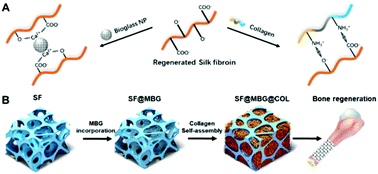Outer–inner dual reinforced micro/nano hierarchical scaffolds for promoting osteogenesis†
Abstract
Biomimetic scaffolds have been extensively studied for guiding osteogenesis through structural cues. Inspired by the natural bone growth process, we have employed a hierarchical outer–inner dual reinforcing strategy, which relies on the interfacial ionic bond interaction between amine/calcium and carboxyl groups, to build a nanofiber/particle dual strengthened hierarchical silk fibroin scaffold. This scaffold can provide an applicable form of osteogenic structural cue and mimic the natural bone forming process. Owing to the active interaction between compositions located in the outer pore space and the inner pore wall, the scaffold has over 4 times improvement in the mechanical properties, followed by a significant alteration of the cell–scaffold interaction pattern, demonstrated by over 2 times elevation in the spreading area and enhanced osteogenic activity potentially involving the activities of integrin, vinculin and Yes-associated protein (YAP). The in vivo performance of the scaffold identified the inherent osteogenic effect of the structural cue, which promotes rapid and uniform regeneration. Overall, the hierarchical scaffold is promising in promoting uniform bone regeneration through its specific structural cue endowed by its micro–nano construction.



 Please wait while we load your content...
Please wait while we load your content...